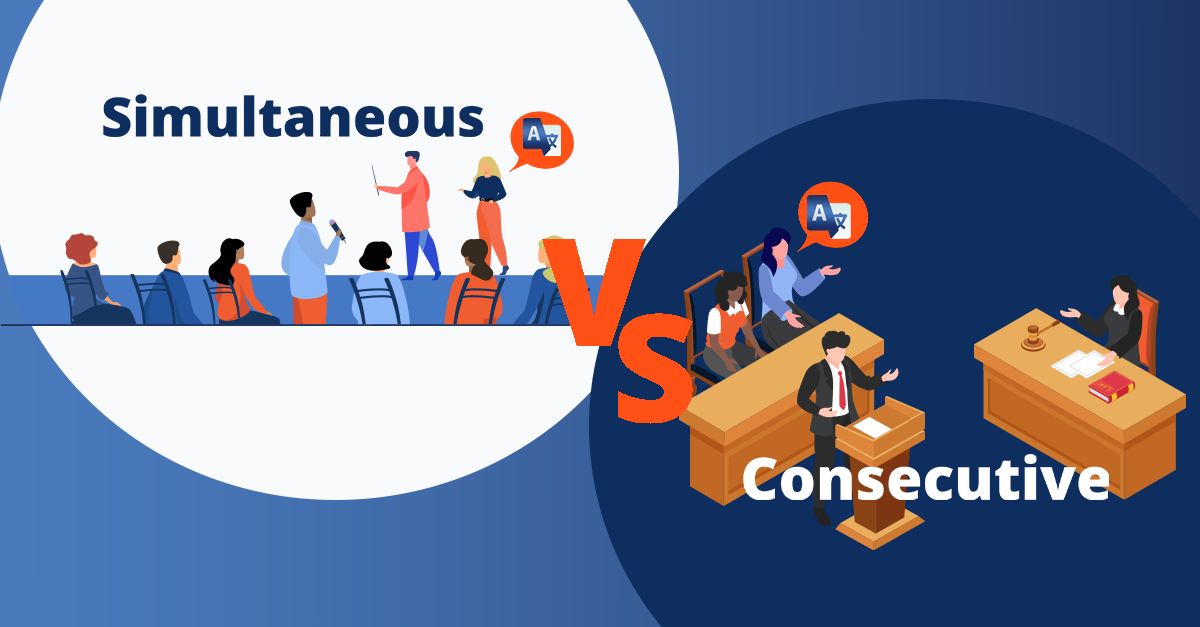Your language interpretation needs will hinge primarily on the setting and your participants. In general, one-on-one conversations like medical appointments usually require consecutive interpretation; a one-to-many model, such as a conference, benefits more from simultaneous interpretation.
There are significant advantages to using one over the other for specific situations, but both approaches, when used appropriately with a professional linguist, keep everyone on the same page.
What’s the Difference Between Simultaneous and Consecutive Interpretation?
Consecutive interpretation is best used for one-on-one delivery models because one person speaks and pauses while the interpreter relays the message. When the other party answers, the interpreter repeats what they said to the first party, and so on until the meeting concludes. This interpretation model follows the speed of the conversation and the comprehension of the participants.
Professional linguists know more than just the mechanics of a language; they’re well-versed in semantics and understand the connection between language and culture. Although consecutive interpretation can take longer, the interpreter conveys context, using non-verbal cues to retain better control over delivery of the message and avoiding potential cultural conflicts. Moreover, the parties can also ask clarifying questions and for repetition from the interpreter to pick up any missed details.
Simultaneous interpretation, on the other hand, works great for events like conferences or Zoom meetings for colleagues spread across the globe. In this scenario, the interpreter is working at a lightning-fast speed, relaying words in real time—just seconds, really—after the person speaks. In these instances, the interpreter may focus less on non-verbal cues like body language and facial expressions because their attention is on translating the words of one person to an audience of many.
The advantage of simultaneous interpretation is that listeners only hear their own language, not that of the speaker or of anyone else in the meeting. Of course, this means special equipment could be necessary, such as a set of headphones for each participant and a control board, to be sure the correct matches are made between the interpreter and the applicable listener.
Which Situations Call for Simultaneous vs. Consecutive Interpretation?
Consecutive Interpretation
When a dialogue or conversation takes place and interpretation solutions are needed, consecutive interpretation is most likely the best solution. Although in-person or on-site interpretation is usually the best method because visual cues go a long way in relaying the proper context of a message, it can also be done over the phone.
In the scenario where the interpreter and the speaker don’t have visual contact, you’re more likely to experience a word-for-word interpretation. In that case, you do run the risk that not seeing the body language and facial expressions of the speaker will skew the message.
Job interviews and parent-teacher conferences are examples of instances when consecutive interpretation works great, but it also has a place in scenarios where communication is more critical. Medical appointments and court proceedings, such as depositions, can be challenging for people who have low language proficiency so having an interpreter present can ensure vital information is clearly communicated and understood by both parties.
Simultaneous Interpretation
Live presentations tend to work well with simultaneous interpretation because there is typically only one person at a time speaking to a group, even in a remote setting. Ideally, of course, materials like speeches and meeting decks would have been given to the interpreter prior to the event to ensure a more accurate delivery of the message.
Examples of live presentations include conferences, virtual meetings where visual clues help enrich the message, and gatherings with multiple language needs such as meetings of the United Nations. You can imagine how doctors around the globe might have benefitted from simultaneous interpretation solutions to collaborate on the development of coronavirus vaccines.
If you’ve been to a concert recently or watched one on TV, you may have seen an example of simultaneous interpretation in action. American Sign Language interpreters often appear on stage with musical acts such as Beyonce and Eminem, and recently at a Harry Styles concert during which he performed Queen’s “Bohemian Rhapsody.”
Which Interpretation Solution Best Fits My Needs?
If you’re wondering if consecutive or simultaneous interpreting will best suit your needs, first review the setting: Is this more of a two-way or a one-way conversation?
With consecutive interpretation, speakers and listeners alike have more time to understand the message because the interpreter can paraphrase and convey more context behind the actual words being spoken. Simultaneous interpreters work seemingly at the speed of light and just a beat or two behind the speaker so audience members at a conference, for example, can follow along in real time.
Choosing between consecutive versus simultaneous interpretation is just one decision to make when defining and filling your language solution needs. Let's talk about your organization's interpretation strategy and come up with a plan that meets all of your needs. Contact our experts to get started.



